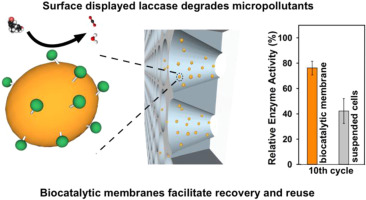当前位置:
X-MOL 学术
›
J. Membr. Sci.
›
论文详情
Our official English website, www.x-mol.net, welcomes your
feedback! (Note: you will need to create a separate account there.)
Biocatalytic Membranes Prepared by Inkjet Printing Functionalized Yeast Cells onto Microfiltration Substrates
Journal of Membrane Science ( IF 8.4 ) Pub Date : 2018-03-01 , DOI: 10.1016/j.memsci.2017.12.045 Yingying Chen , Peng Gao , Mark J. Summe , William A. Phillip , Na Wei
Journal of Membrane Science ( IF 8.4 ) Pub Date : 2018-03-01 , DOI: 10.1016/j.memsci.2017.12.045 Yingying Chen , Peng Gao , Mark J. Summe , William A. Phillip , Na Wei

|
Abstract Biocatalytic cells displaying functional enzymes on their surface have the ability to catalyze the degradation of persistent micropollutants with high enzyme accessibility and stability. However, the high migration and limited processing capability of suspended biocatalytic cells remain major challenges for practical applications in water treatment. In this study, we fabricated biocatalytic membranes (BCMs) by immobilizing biocatalytic cells, i.e., Baker's yeast with cell surface display laccase (SDL), on microporous membranes via inkjet printing and chemical crosslinking. The incorporation of SDL biocatalytic cells on the surface of the membranes was confirmed by microscopy, elemental analysis, and enzyme assay tests. Moreover, it was demonstrated that the number of SDL cells incorporated and therefore, the enzyme activity of the BCMs, could be systematically controlled by altering the printing parameters. The viability, regeneration, and high storage stability of SDL cells were maintained in the BCM platform. Furthermore, the BCMs could be reused with high stability as they retained 76% of their initial activity after ten repeated reaction cycles. In comparison, the activity of freely-suspended SDL cells declined to 42% of their initial activity after ten reaction cycles. Finally, the effectiveness of BCMs in treating emerging contaminants was confirmed using bisphenol A and acetaminophen as substrates in proof-of-concept experiments. The results of this study establish that BCMs can address concerns related to the utilization of suspended biocatalytic cells by fixing them on a microporous substrate. With further study and optimization, BCMs have the potential to be incorporated into membrane-based separation and pollutant degradation processes.
中文翻译:

通过将功能化酵母细胞喷墨打印到微滤基质上制备的生物催化膜
摘要 在其表面显示功能酶的生物催化细胞具有催化持久性微污染物降解的能力,具有较高的酶可及性和稳定性。然而,悬浮生物催化细胞的高迁移率和有限的处理能力仍然是水处理实际应用的主要挑战。在这项研究中,我们通过喷墨印刷和化学交联将生物催化细胞(即具有细胞表面展示漆酶(SDL)的贝克酵母)固定在微孔膜上来制造生物催化膜(BCM)。通过显微镜、元素分析和酶分析测试证实了 SDL 生物催化细胞在膜表面的结合。此外,还证明了纳入的 SDL 细胞数量,因此,BCM 的酶活性可以通过改变打印参数来系统地控制。BCM 平台保持了 SDL 细胞的活力、再生和高储存稳定性。此外,BCM 可以以高稳定性重复使用,因为它们在十次重复反应循环后仍保留其初始活性的 76%。相比之下,自由悬浮的 SDL 细胞的活性在十个反应循环后下降到其初始活性的 42%。最后,在概念验证实验中,使用双酚 A 和对乙酰氨基酚作为底物证实了 BCM 在处理新出现的污染物方面的有效性。这项研究的结果表明,BCM 可以通过将悬浮生物催化细胞固定在微孔基材上来解决与利用悬浮生物催化细胞相关的问题。随着进一步研究和优化,
更新日期:2018-03-01
中文翻译:

通过将功能化酵母细胞喷墨打印到微滤基质上制备的生物催化膜
摘要 在其表面显示功能酶的生物催化细胞具有催化持久性微污染物降解的能力,具有较高的酶可及性和稳定性。然而,悬浮生物催化细胞的高迁移率和有限的处理能力仍然是水处理实际应用的主要挑战。在这项研究中,我们通过喷墨印刷和化学交联将生物催化细胞(即具有细胞表面展示漆酶(SDL)的贝克酵母)固定在微孔膜上来制造生物催化膜(BCM)。通过显微镜、元素分析和酶分析测试证实了 SDL 生物催化细胞在膜表面的结合。此外,还证明了纳入的 SDL 细胞数量,因此,BCM 的酶活性可以通过改变打印参数来系统地控制。BCM 平台保持了 SDL 细胞的活力、再生和高储存稳定性。此外,BCM 可以以高稳定性重复使用,因为它们在十次重复反应循环后仍保留其初始活性的 76%。相比之下,自由悬浮的 SDL 细胞的活性在十个反应循环后下降到其初始活性的 42%。最后,在概念验证实验中,使用双酚 A 和对乙酰氨基酚作为底物证实了 BCM 在处理新出现的污染物方面的有效性。这项研究的结果表明,BCM 可以通过将悬浮生物催化细胞固定在微孔基材上来解决与利用悬浮生物催化细胞相关的问题。随着进一步研究和优化,











































 京公网安备 11010802027423号
京公网安备 11010802027423号